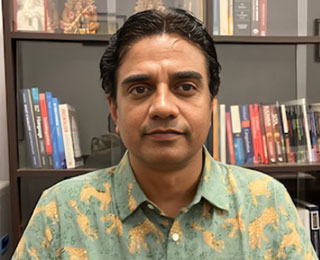How Linguistics Converges With Cognitive Science, Psychology, & AI & ML

Rajesh Kumar, Professor, IIT Madras
In an exclusive interview with Higher Education Review, Rajesh Kumar, Professor, IIT Madras, shares his view on the role of language in shaping cognitive functions, how language processing aligns with linguistic theories of syntax and semantics, ethical considerations arising from the use of AI/ML in language technologies, the psychological effects of learning a second language and more. Prior to joining IIT Madras, Rajesh taught at IIT Kanpur and IIT Patna in India and at the University of Texas at Austin in the USA. The broad goal of his research is to uncover regularities underlying both the structural form and sociolinguistic functions of natural language
How do linguistic theories inform our understanding of cognitive processes? What role does language play in shaping cognitive functions?
Linguistic theories and cognitive processes are two aspects that interact with one another. The cognitive process is the subconscious processing of multiple activities in the human mind. Language is one of the most sophisticated outputs or products of the human mind. It languishes as such highly attracted interest from a wide range of scholars, including from sociology, philosophy, biology, mathematics, and computer science, and the emergence of the entire domain of computer science is predicated on the study of language. As far as cognition is concerned, it is the understanding processes of the human mind. For instance, looking at learning a language, predominantly by a child, how to explain it takes attention to cognitive science in the sense that human cognition for learning languages is very complex.
A child learns to speak the language of their immediate environment without any instruction and any nuances. A child starts performing at age five or six, and as it goes on, it becomes very complex, but we have a very minimal understanding of how it works. Hence, language is the only part of human cognition that we learn without much effort, and putting in a little effort and talking about learning a language happens automatically as a child and not with the concepts at a later stage.
How do cognitive processes like memory and attention influence language acquisition and processing? How do cognitive models of language processing align with linguistic theories of syntax and semantics?
Memory, language retention and language processing are all independent processes. In language study, memory is what we retain with us. However, language learning does not work with memory, in the sense that when we learn
a language, we do not memorize the lines, and this is why the processing of languages is the internal mental capacity of humans, not memorizing. Language processing in the human mind is a complete computational process, which is internal to the human mind, and they are born with this capacity rather than developing it.
Linguistic theory helps us explain the process of understanding language: how we learn, retain, and use languages. Syntax is a theoretical apparatus or tool that helps analyze language at the sentence level, while semantics helps understand the embedded meaning of that. When Linguistic theory is put together, it draws certain conclusions that can be very scary to mankind.
How do natural language processing (NLP) techniques draw from linguistic theories?
For a machine to work on natural language processing, the first thing the machine has to perform in terms of the mathematical algorithm is replicating the human mind’s capacities. With all the advantages and advancements that we see in the field of language processing and the development of machine multitasking, any capacity that a machine acquires and develops is replicated from the human capacity to communicate. Hence, we call that whole process natural language processing. There is a difference between natural language and artificial language. Natural language is the language humans speak, while Artificial language is the machine language machines use to communicate. It is called artificial because it has been designed and developed by humans using simple codes.
For example, doctors communicate with codes, and that’s the distinction between artificial and natural language. To process through the device predicated upon artificial languages, machines need to process natural lengths to yield the results we intended. Eventually, the goal is that the machine should be able to work the way the human mind works in terms of processing natural language.
How do cognitive and linguistic models integrate in AI applications like speech recognition and machine translation? What ethical considerations arise from the use of AI/ML in language technologies?
Ethical concerns are minimal and depend on the user’s part, and these developments are in primitive states. The most telling examples of language processing, natural language processing, artificial intelligence, and machine learning are in Chap GPT, the most prominent area in which we see their uses. Chat GPT retains information from various sources, and when users ask questions, it picks up information and delivers it in a patterned manner. However, inappropriate use leads to plagiarism as it provides similar information to other users.
There are no ethical concerns about an interruption in scientific development. Nevertheless, scientific development works independently or parallels these concerns, and it’s hard to predict the next generation of machines. Human beings will need to deal with many ethical, social, and moral challenges independent of the development of machines.
What are the psychological effects of learning a second language on cognitive development and functioning?
Learning a second language is predicated on the first language. It needs motivation as far as psychological concerns are required, in the sense that if there is no strong motivation to learn the language. If someone is not compulsive in learning a new language, that person will never learn anything. Hence, motivation and compulsion work together, and they have two sides of the same point: to help people acquire a second language, which will always be based on the capacity of the first language. Also, this is the psychological connection and cognitive processing between the first and second languages.
How do linguistic theories inform our understanding of cognitive processes? What role does language play in shaping cognitive functions?
Linguistic theories and cognitive processes are two aspects that interact with one another. The cognitive process is the subconscious processing of multiple activities in the human mind. Language is one of the most sophisticated outputs or products of the human mind. It languishes as such highly attracted interest from a wide range of scholars, including from sociology, philosophy, biology, mathematics, and computer science, and the emergence of the entire domain of computer science is predicated on the study of language. As far as cognition is concerned, it is the understanding processes of the human mind. For instance, looking at learning a language, predominantly by a child, how to explain it takes attention to cognitive science in the sense that human cognition for learning languages is very complex.
A child learns to speak the language of their immediate environment without any instruction and any nuances. A child starts performing at age five or six, and as it goes on, it becomes very complex, but we have a very minimal understanding of how it works. Hence, language is the only part of human cognition that we learn without much effort, and putting in a little effort and talking about learning a language happens automatically as a child and not with the concepts at a later stage.
How do cognitive processes like memory and attention influence language acquisition and processing? How do cognitive models of language processing align with linguistic theories of syntax and semantics?
Memory, language retention and language processing are all independent processes. In language study, memory is what we retain with us. However, language learning does not work with memory, in the sense that when we learn
a language, we do not memorize the lines, and this is why the processing of languages is the internal mental capacity of humans, not memorizing. Language processing in the human mind is a complete computational process, which is internal to the human mind, and they are born with this capacity rather than developing it.
Linguistic theory helps us explain the process of understanding language: how we learn, retain, and use languages. Syntax is a theoretical apparatus or tool that helps analyze language at the sentence level, while semantics helps understand the embedded meaning of that. When Linguistic theory is put together, it draws certain conclusions that can be very scary to mankind.
How do natural language processing (NLP) techniques draw from linguistic theories?
For a machine to work on natural language processing, the first thing the machine has to perform in terms of the mathematical algorithm is replicating the human mind’s capacities. With all the advantages and advancements that we see in the field of language processing and the development of machine multitasking, any capacity that a machine acquires and develops is replicated from the human capacity to communicate. Hence, we call that whole process natural language processing. There is a difference between natural language and artificial language. Natural language is the language humans speak, while Artificial language is the machine language machines use to communicate. It is called artificial because it has been designed and developed by humans using simple codes.
For example, doctors communicate with codes, and that’s the distinction between artificial and natural language. To process through the device predicated upon artificial languages, machines need to process natural lengths to yield the results we intended. Eventually, the goal is that the machine should be able to work the way the human mind works in terms of processing natural language.
How do cognitive and linguistic models integrate in AI applications like speech recognition and machine translation? What ethical considerations arise from the use of AI/ML in language technologies?
Ethical concerns are minimal and depend on the user’s part, and these developments are in primitive states. The most telling examples of language processing, natural language processing, artificial intelligence, and machine learning are in Chap GPT, the most prominent area in which we see their uses. Chat GPT retains information from various sources, and when users ask questions, it picks up information and delivers it in a patterned manner. However, inappropriate use leads to plagiarism as it provides similar information to other users.
There are no ethical concerns about an interruption in scientific development. Nevertheless, scientific development works independently or parallels these concerns, and it’s hard to predict the next generation of machines. Human beings will need to deal with many ethical, social, and moral challenges independent of the development of machines.
What are the psychological effects of learning a second language on cognitive development and functioning?
Learning a second language is predicated on the first language. It needs motivation as far as psychological concerns are required, in the sense that if there is no strong motivation to learn the language. If someone is not compulsive in learning a new language, that person will never learn anything. Hence, motivation and compulsion work together, and they have two sides of the same point: to help people acquire a second language, which will always be based on the capacity of the first language. Also, this is the psychological connection and cognitive processing between the first and second languages.

